Pros
Cons
Introduction
We have tested and compared the best of this line, the BlackCrystal JLE47BC3001 ($999 MSRP), against an older JVC model from this year, one of the best VIZIO models and a comparably priced Samsung television. We liked what we saw, but some of the marketing ploys don't match up with our testing.
Overall Design
{{section_header}}{{section.name}}{{/section_header}}
One of the main features of the new BlackCrystal line from JVC is supposed to be the sleek design. We agree that they have made the width of the panel quite thin, like all other edgelit LED models on the market. But when you look at it from the front, as you will most times, sleek is not the word that comes to mind. The bezel is too thick to be dapper and the speaker bar at the bottom reminds us of HDTVs from the turn of the century.
Front
{{section_header}}{{section.name}}{{/section_header}}

Back
{{section_header}}{{section.name}}{{/section_header}}

Sides
{{section_header}}{{section.name}}{{/section_header}}

Stand/Mount
{{section_header}}{{section.name}}{{/section_header}}
The stand is a thick plastic foundation. It is larger than most fashionable televisions these days, but it is not as sturdy somehow. The screen wobbles quite a bit with minimal touching, to the point of unease. There is no motion in the neck and so it will be harder to get at the port connections on the side and back as it would with other, sleekly designed televisions.

Controls
{{section_header}}{{section.name}}{{/section_header}}
The manual controls are out of the way and easy to get to. The keys are a little hard, and there are no bumps to let you know which button you are pressing. You will figure out the order after a while of ownership, but it may be a challenge at first when watching in the dark.

Remote Control
{{section_header}}{{section.name}}{{/section_header}}
The remote for the {{product.name}} is very basic, controlling only the television and the USB media options. It is small and light. Most buttons are easy to reach without adjusting your hand. The middle buttons, like the menu controls, are indistinguishable in the dark. There is no backlight for this controller, and it may take some time to learn where the right buttons lay.

In the Box
{{section_header}}{{section.name}}{{/section_header}}
In the box was a manual, a remote, batteries, a television, and some warranty documents.
Black Level
{{section_header}}{{section.name}}{{/section_header}}
The deepest black on this LCD from JVC is not spectacular. Differences in black level are significant because luminance is on a logarithmic scale, meaning that each small numerical difference in black level has a large affect on perceivable light levels. Usually a value of less than 0.1 cd/m2 we consider high quality. The {{product.model}} doesn't quite cut it. More on how we test black level.
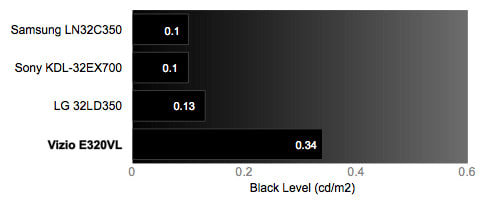
Peak Brightness
{{section_header}}{{section.name}}{{/section_header}}
The peak brightness of the {{product.name}} slightly makes up for the unsatisfying black level. Notice that the peak brightness of the {{product.model}} is much more similar to the VIZIO than the other JVC in the comparison. This similarity shows that JVC's decision to switch to AmTRAN, the manufacturer of VIZIO, has made a big difference in the type of display they sell. More on how we test peak brightness.
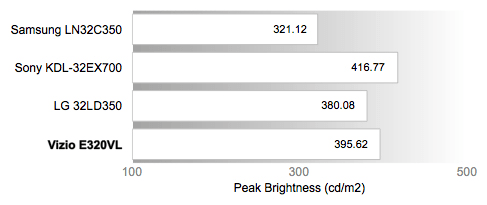
Contrast
{{section_header}}{{section.name}}{{/section_header}}
With such a strong peak brightness, the {{product.model}} ends up having a good contrast ratio. You can see in the chart below that the Samsung far surpasses these competitors with a really rich black level, rather than having the highest peak brightness. More on how we test contrast.

Tunnel Contrast
{{section_header}}{{section.name}}{{/section_header}}
The chart you see below shows that the {{product.model}} screen does not dim depending on the images displayed. Using various black boxes, we change the percentage of area of screen displaying pure black, from 100% to 5%, and measure the luminance at the center to see if any changes occur. The relatively straight line in the chart tells us that the lighting elements behind the display do not dim with changes in imagery. More on how we test tunnel contrast.
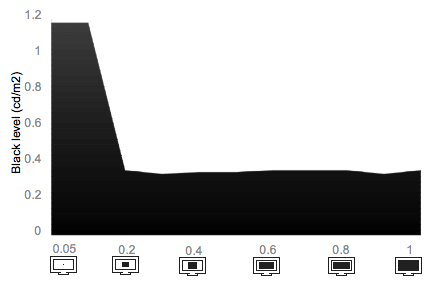
White Falloff
{{section_header}}{{section.name}}{{/section_header}}
Like the previous test, our White Falloff test checks to see if is the brightest whites are affected by changes in areas of pure white. That straight line right around 370 cd/m2 says that the brightness is not affected by the images on the screen. More on how we test white falloff.
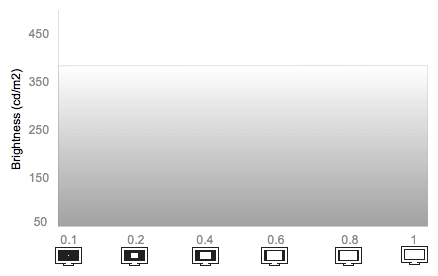
Uniformity
Greyscale Gamma
{{section_header}}{{section.name}}{{/section_header}}
In the chart below, there is a reasonably accurate greyscale gamma graph. The smoothness of the line is important, showing that no values from darkest dark to brightest white are skipped. For the most part, the line is wonderfully smooth, but there are a few bumps right at the middle grey section. We saw this play out on a black to white gradient. Some sections of the gradient were the wrong level of brightness for their position, standing out as bright or dark lines in an otherwise smooth transition.
The slope of the line is a little too steep. The ideal slope is 2.15 +/- .05, which would mean the television displays the standard brightness for the given input. With a slope of 2.63, this graph transitions too quickly from deepest black to brightest white and you will lose some detail in the brightest and darkest values.
Overall, this is an above average gamma graph, though it's not top-quality either. More on how we test greyscale gamma.
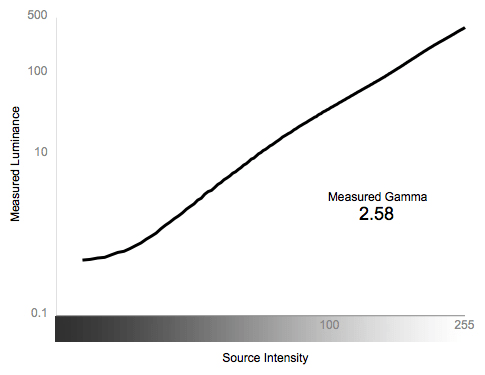
Color Temperature
{{section_header}}{{section.name}}{{/section_header}}
This color temperature is near perfect. There appears to be one small peak of overly cool color temperature that happens at only a handful of values in the darkest greys. At this very specific part in the gradient, there may be the slightest bit of perceivable cooling, like a blueish tint. We are pretty sure you will never be able to see this however because it is so slight and confined to only a few specific values. More on how we test color temperature.

RGB Curves
{{section_header}}{{section.name}}{{/section_header}}
These color curves show some respectable color accuracy. The lines are smooth, thereby not skipping many values. The three lines of the primary colors are in line with one another, showing consistency in color brightness. For example, at no point will red be brighter than green, showing unnaturally bright reds for what is supposed to be on the screen.
The curve of the line is a little saggy at the beginning. This means that colors do not really get to the correct brightness until the middle range of the spectrum. Also, all of the lines peak a little early. At a certain point, colors can be no brighter, though the signal asks for a brighter value. Some detail in the brightest images will be lost to this peaking, but it is not extreme.
Overall, these color curves are mostly correct, a point of quality that is hard to achieve because it requires strong engineering and expensive hardware. More on how we test RGB curves.

Below are graphical representations of the color curves we've just discussed. We compare these color strips to the ideal response to see how the imperfections match up to the standard. Most obvious, is how dark the spectrum stays until it gets bright enough to be recognizable color.
Motion Performance
{{section_header}}{{section.name}}{{/section_header}}
We turn on any motion processing functions during our motion tests to give each television the best performance possible for scoring. However, we also recommend that when watching actual content, you probably do not want these functions engaged. Often, motion processing functions, like CrystalMotion found on the {{product.model}}, make film-based content look overly smooth. The result makes video look like something shot on a home camera, or just cheaply made like a Soap Opera.
For testing, the CrystalMotion function helped moving images retain detail and reduce jagged edges, but the overall performance was not so winning. Faces in moving photographs blurred a little, though detailed lines remained separate. Colors trailed as they moved across the screen. High frequency patterns picked up significantly more jagged lines throughout the pattern. In all of these tests, the outline of the object skewed in motion. This shows that the internal processor cannot render a moving object quickly enough to catch the top part of the object up with the bottom. Though not awful, the motion performance was not striking like you see on some of the top-tier brands. More on how we test motion performance.
3:2 Pulldown & 24fps
{{section_header}}{{section.name}}{{/section_header}}
The Film Mode setting on the {{product.name}} significantly reduces flicker in 24fps content. However, it does not completely eliminate it. This suggests that Film Mode uses a 3:2 pulldown method, a process that interpolates frames to match 24 to a factor of 120, the refresh rate of the screen, rather than changing the refresh rate to 24Hz to match the content exactly. In our tests, Film Mode, set to Auto, worked really well, reducing flicker and judder for film content produced at 24fps, like what you get from most Blu-ray videos. More on how we test 3:2 pulldown and 24fps.
Resolution Scaling
{{section_header}}{{section.name}}{{/section_header}}
The {{product.name}} displays natively at 1080p, though much of the content being input into your TV comes at a different resolution, often 720p for HD broadcast stations and 480p for standard definition. In 1080p, we noticed some false coloration to high frequency patterns, i.e. anything with a heavy detail. Otherwise pictures were manifested beautifully. More on how we test resolution scaling.
480p
In 480p, we could not get rid of the 3% vertical and 2% horizontal overscan. This clipping is fairly normal when switching from 16:9 HD format to the 4:3 standard format. When we ran the resolution tests, the overscan did not cause any of the usual problems, such as banding of high frequency patterns. All patterns were displayed with full detail.
720p
Everything displayed perfectly in 720p. There was no banding or mushing together of detailed images. Being professional sticklers, we took off a fraction of a point for text, because the smallest text was not as clearly legible as it could have been.
Formats
{{section_header}}{{section.name}}{{/section_header}}
The {{product.name}} displays natively at 1080p and can show all NTSC standard formats.
Viewing Angle
{{section_header}}{{section.name}}{{/section_header}}
The chart below is an excellent comparison showing the difference between old JVC models and the new BlackCrystal line manufactured by AmTRAN, the same company that makes VIZIO models. You can see that the {{product.model}} is much more similar to the VIZIO than to an older JVC. It looks like the viewing angle is now a little narrower than it used to be, but not bad for an LCD model.

Reflectance
{{section_header}}{{section.name}}{{/section_header}}
The screen on the {{product.model}} is very bright, so external lights will not compete with the images on the television. We shined bright LED lights at the screen during some shadowy content and noticed that the lights were not distracting. The reflection pattern showed a rainbow dispersion, meaning that the white light produced by the LEDs was broken into its component colors, thus dispersing the light rather than just reflecting it. Adding angle to the lights made them even less noticeable. This JVC will be a good fit for any lighting environment in your home.
Video Processing
{{section_header}}{{section.name}}{{/section_header}}
There were not too many video processing modes on the {{product.model}}. Of what there were, not many made a difference.
Calibration
{{section_header}}{{section.name}}{{/section_header}}
With a few adjustments, you can calibrate the {{product.name}} to match HDTV industry standards as we have. Beneath this section is a table showing the factory settings and our calibration using several standardized tests provided by DisplayMate software.

All of our calibration is done in conjunction with the DisplayMate software.
](http://www.displaymate.com/)
Video Modes
{{section_header}}{{section.name}}{{/section_header}}
There are a few preset video modes on this JVC, intended for different types of content.
Connectivity
{{section_header}}{{section.name}}{{/section_header}}
On the {{product.model}}, the digital ports are kept separately from the analog ones. There are four HDMI ports and two USB ports arranged vertically and an analog audio, a component video, and a VGA connection on the horizontal part of the L-shaped cutout on the back. This organization makes sense to us. With analog fading into the days of human past, you will want easier access to the HDMI and USB ports. Unlike some televisions, that have done away with analog all together, this JVC knows that some older devices still linger, and that the very popular Wii is an analog connector also. There is only one analog port however, so you will only be able to connect one of your devices at a time.

We also thought it important to make a note to all consumers: Be advised. The JVC BlackCrystal JLE47BC3001 supports PC input via VGA connection without error, but when using an HDMI cable, only resolutions 1024x768 and lower are supported. Your PC will sense a full 1080p (1920x1080) resolution from the TV, but when the TV attempts to display this resolution, it will undergo an error, displaying a blank screen. JVC has confirmed this.
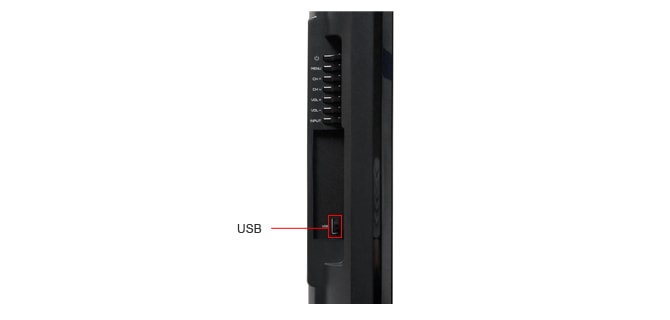
Placement
{{section_header}}{{section.name}}{{/section_header}}
On the left side, on the back, the ports are arranged in digital and analog sections in an L-shaped cutout near the manual controls. This type of arrangement works well when you can swivel the stand. A slight turn of the display and you have access to all of the ports right away. Without any movement in the neck of the stand, making connections on the {{product.name}} is a bit of a chore. If you have to turn the whole television to get at the ports, the connections may as well be in a large rectangular array in the back. The L-shape makes the user have to look underneath to see the connections, which again makes for a quick look at the connections if the TV can turn on its own, but becomes a second task after turning the whole television in the first place.
Audio Quality
{{section_header}}{{section.name}}{{/section_header}}
The Press Release regarding the new BlackCrystal line from JVC speaks to the focus on audio quality:
"All [BlackCrystal models] were developed with particular emphasis on high-quality audio performance as well as clear video performance. All models offer direct-firing speakers; a special audio cavity to help sound resonance; better-quality speakers with built-in tweeters, a wider frequency range (20kHz) and deeper base response."
However, in the specifications, the speakers are listed as only 10W. Most HDTVs come equipped with 10W speakers. A deeper bass response could be achieved by adding a subwoofer. Some TVs come with a small woofer in the back, but the {{product.name}} does not. Bose systems create voluminous sound by bouncing the sound waves around a sound cavity, similar to what JVC claims to have in the BlackCrystal line, but such a feature is not really possible on these TVs. The design employs E-LED backlighting, purposefully intending to keep the profile thin, meaning that there is no space for a sound cavity.
We could not hear a significant upgrade in sound compared to similarly priced televisions. In fact, the sound quality was at best average. We have heard better systems coming from the same wattage output on Sony and LG.
Another marketed feature is the SRS StudioSound setting that attempts to mimic a Dolby 5.1 surround setup by bouncing sound waves off the walls around you. It doesn't work that well. The feeling of sound surrounding you just is not there. We will say that this setting seems to increase the quality of the sound, thus increasing our enjoyment of explosions and gun violence. We recommend turning this setting on for most content, but more so, we recommend that you get some external speakers.
Menu Interface
{{section_header}}{{section.name}}{{/section_header}}
The menus are handsome and easy (there's a joke to be made here but it's probably inappropriate). There are no advanced features to control, so the organization of setting options is intuitive. They appear on the left side as a column when you press the Menu button on the remote. Each one of the selections has a menu that tabs out to the right, with subsequent menus tabbing out again, creating clear stages of organization.

Instruction Manual
{{section_header}}{{section.name}}{{/section_header}}
The Manual is a bit thin. There are not many advanced features to describe, but there is also not much detail. For instance, we could not find a list of supported file formats for the USB port, and therefore did not have much success using it. Consumers may have the same problem. There is a helpful table of contents that will get you to the sections you need, but it lacks an index and tabs for quick reference.

A manual for so many TV models, they have to be further categorized by type.
Internet Features
{{section_header}}{{section.name}}{{/section_header}}
The {{product.name}} has no internet features.
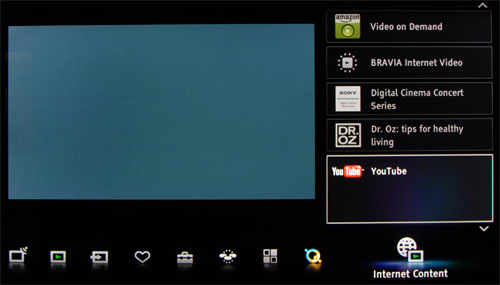
Local Media Playback
{{section_header}}{{section.name}}{{/section_header}}
There are two USB ports on the {{product.model}} that are intended for media playback of music, video, and pictures. None of the manuals we could find listed the files that this port will accept. We tried a host of picture types, video, and music with varying success. We encountered situations where one photo would display and another would not, though they were the same file type created in the same software program. The system didn't like our mp3 file. Considering most digital music is in this format, we are a little skeptical.
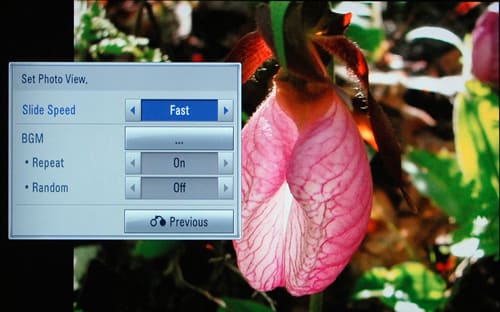
This media port is probably most useful for photos taken straight from a camera. Controlling a slideshow (the speed of the slides, the transition types, and the size of the photos) is easy to do and we could see this being a fun post-vacation demonstration for guests.
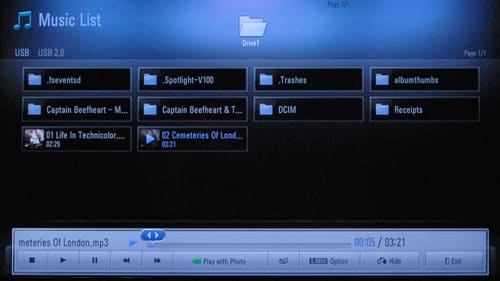
Power Consumption
{{section_header}}{{section.name}}{{/section_header}}
Most LCD screens require only a small amount of electricity to operate. Extra features like 3D imaging and WiFi can boost the Watts required to run a television, but the {{product.name}} has no such features and thus has an almost negligible yearly cost.
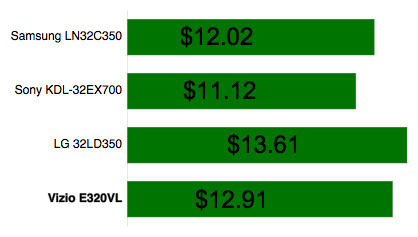
Value Comparison
{{section_header}}{{section.name}}{{/section_header}}
The JVC LT-42E910 is from earlier this year and is priced exactly the same as their new BlackCrystal JLE47BC3001. You get a few more inches of screen out of the newer BlackCrystal and the screen is made by a completely different manufacturer, so the performance is significantly changed. We like the BlackCrystal model for its brightness and color performance. The LT-42E910's superior contrast ratio is not enough to counter these strong points of quality.
Blacks & Whites
{{section_header}}{{section.name}}{{/section_header}}
The black level on the older JVC was really strong for an LCD. A deep black level like this will make for a good contrast ratio. Though the BlackCrystal model had such a sterling peak brightness, it lost out on contrast because it did not have the rich black level of the older model.
Thought the LT-42E910's contrast ratio is larger than the BlackCrystal, the peak brightness is poor enough that it may be hard to watch in a brightly lit room. To determine which one is better, you have to consider the environment in which the prospective set will be viewed within your home.

Color Accuracy
{{section_header}}{{section.name}}{{/section_header}}
Comparing color temperature is comparing near perfect to horrendously awful. The BlackCrystal's color temperature stays consistent throughout the entire spectrum, whereas the LT-42E910 had a spike of cooling that blew off of our charts, receiving a total score of 0.
The color curves rendered very similar scores. We prefer the BlackCrystal when comparing the graphs. The LT-42E910 had red values that were too bright throughout the spectrum. The BlackCrystal's colors peaked a little early, but they were at least consistent with each other throughout the test.
The BlackCrystal model also had a more accurate set of colors according to the Rec. 709. We would go with the BlackCrystal.
Motion
{{section_header}}{{section.name}}{{/section_header}}
The LT-42E910 needed to use motion interpolating processing to artificially reach refresh rates of 120Hz, but even with this function on it did not perform well.
The BlackCrystal model has a natural refresh rate of 120Hz without any interpolating, as well as motion processing abilities that bring it up from there.
Viewing Effects
{{section_header}}{{section.name}}{{/section_header}}
JVC's former screen manufacturers were able to produce screens with very wide viewing angles for LCD displays, like what you see on the LT-42E910. AmTRAN looks like they are capped at about 35º off center, and so this JVC BlackCrystal has an average viewing angle for an LCD, comparable to the VIZIO in the chart.
Connectivity
{{section_header}}{{section.name}}{{/section_header}}
JVC has traded an analog port for an HDMI port. The LT-42E910 has more analog ports, the BlackCrystal has more of HDMI. The determinant is based on the devices you currently have or wish to purchase. If everything you have or will have is new, go with the BlackCrystal. If you have some valuable electronics that need analog connections, the LT-42E910 will be the better choice.
Value Comparison
{{section_header}}{{section.name}}{{/section_header}}
These two televisions are manufactured by the same company, AmTRAN. VIZIO prides itself on making HDTVs with good performance while being some of the cheapest around. The BlackCrystal line from JVC is intended to have strong performance, coming in at a price point just below the biggest brands.
In terms of quality, it is a tough call between these two sets. The JVC has a stronger contrast ratio, the VIZIO has a more accurate set of colors. Otherwise, these two sets, made by the same manufacturer, are very similar. But when you look at the price, it's hard for us to recommend the BlackCrystal here. For about half as much, you can get a very comparable VIZIO television with the same amount of screen. VIZIO is our choice in this comparison.
Blacks & Whites
{{section_header}}{{section.name}}{{/section_header}}
The JVC here has a better contrast ratio thanks to a deeper black level. Their peak brightnesses are comparable, but the black level makes all the difference.

Color Accuracy
{{section_header}}{{section.name}}{{/section_header}}
Other than color temperature, where the VIZIO showed some cool tinting to the darkest values, it had better color performance than the JVC in every category.
Motion
{{section_header}}{{section.name}}{{/section_header}}
Though neither set aced our motion tests, the VIZIO lacked overdrive processing features to help with moving objects. With CrystalMotion turned on, the JVC did slightly better on these tests, though this is a feature we recommend you disengage when watching most content. We will call this one a draw.
Viewing Effects
{{section_header}}{{section.name}}{{/section_header}}
AmTRAN made both these screens, they have almost the same viewing angle.
Connectivity
{{section_header}}{{section.name}}{{/section_header}}
The JVC has two more HDMI connections than the VIZIO, which has an extra analog port. We think the JVC has more value in this category.
Value Comparison
{{section_header}}{{section.name}}{{/section_header}}
JVC is claiming that the BlackCrystal line will provide great quality at a price point beneath top brands like Samsung. Okay, let's test that by comparing this BlackCrystal model with a Samsung model for almost the same amount of money.
To begin, they have the same screen size, so you won't be missing anything there. The Samsung has a drastically better contrast ratio, a more accurate set of colors, much better motion processing, and online streaming content over the JVC. For the same price, we will definitely go with the Samsung.
Blacks & Whites
{{section_header}}{{section.name}}{{/section_header}}
This Samsung has a fantastic black level, especially for an LCD screen, rendering the strongest contrast ratio by more than 2:1 across all of our comparisons in this review.

Color Accuracy
{{section_header}}{{section.name}}{{/section_header}}
The JVC has better color temperature accuracy, slightly better color curves, but the set of colors do not match the standard as well as the Samsung. There is an interchange of benefits between these two. We would prefer the Samsung, for matching the standard more accurately and having color curves that do not peak at the brightest values.
Motion
{{section_header}}{{section.name}}{{/section_header}}
The motion processing on this Samsung was of the strongest for the year. The Samsung engineers are some of the best, and they have made top quality overdrive features that outperform this JVC significantly.
Viewing Effects
{{section_header}}{{section.name}}{{/section_header}}
This could be a big drawback for those considering purchasing the Samsung UN46D6000. Though LCD screens typically do not have wide viewing angles, this one is particularly narrow. If you have a large room, or plan to watch this TV regularly from an angle, you may want to consider going with the JVC.
Connectivity
{{section_header}}{{section.name}}{{/section_header}}
The port connections are pretty much the same. Consider the WiFi connectivity and the best online content interface, the Smart Hub, which comes with the Samsung, and the decision should be obvious.
Conclusion
The {{product.model}} ($999 MSRP) is the top model for this new line of televisions manufactured by AmTRAN and sold by JVC. The goal for this line is to give consumers great quality without being as expensive as top brands. Specific points mentioned in Press Interviews focus on strong audio quality, clear video, and a sleek design.
Testing showed some good results. The peak brightness of the screen was really strong, giving it a solid contrast ratio. The color accuracy was definitely noteworthy in every one of our testing categories. The viewing angle proved to be decently wide for an LCD screen.
But the marketing of this line doesn't match up to our results. The emphasis on sound quality is not supported by the 10W speakers. The SRS StudioSurround was not as immersive as we've heard on other comparable models. The motion processing was above average, but it is not high-quality. The panel is thin, yes, but the design is not exactly fashionable and the edgelighting caused problems with the uniformity of the picture.
Though it is a hair cheaper, this JVC cannot compete with the level of performance we see from top brands, as we show in our Third Comparison in this review. If you are looking for inexpensive with good performance, AmTRAN makes very similar screens for VIZIO that test about the same as this new BlackCrystal series from JVC.
For whom these televisions will work, it is unclear. They are too expensive to be considered high value, and they do not perform as well as the top-tier brands. The BlackCrystal line falls between two consumer niches, satisfying neither.
Model Series Comparison
{{section_header}}{{section.name}}{{/section_header}}
The JLExxBC3001 BlackCrystal line is JVC's series of quality televisions. The focus of this new JVC line, produced by AmTRAN, is to provide quality and value. JVC is trying to sell just under the price points of top brands like Sony, LG, and Samsung, intending these TVs for consumers interested in a strong performing television that won't break the bank.
Each of these models are 1080p displays featuring LED edgelighting, sound engineering with SRS StudioSound (points that did not impress us during testing), HDMI and USB ports (four HDMI on the 47'' and 42'', three on the 37'' and 32''; two USB on the 47'' and 42'', one USB on the 37'' and 32'').
There are no advanced features, like internet connectivity or 3D images. JVC plans to implement these in the next series of displays produced by AmTRAN in a line called the BlackSapphire series to be released soon.
Photo Gallery
{{photo_gallery "Front Tour Image", "Back Tour Image", "Sides Tour Image", "Stand Photo", "Controls Photo", "Remote Control Photo", "Connectivity Tour Image 1", "Connectivity Tour Image 2", "Connectivity Extra Photo", "Menu Main Photo", "Menu 2 Photo", "Internet Features 1 Photo", "Internet Features 2 Photo", "Internet Features 3 Photo", "Local Media Playback 1 Photo", "Local Media Playback 2 Photo"}}
Ratings & Specs
{{manufacturer_specs_table}}
Meet the tester
Christian Sherden is a valued contributor to the Reviewed.com family of sites.
Checking our work.
Our team is here to help you buy the best stuff and love what you own. Our writers, editors, and experts obsess over the products we cover to make sure you're confident and satisfied. Have a different opinion about something we recommend? Email us and we'll compare notes.
Shoot us an email